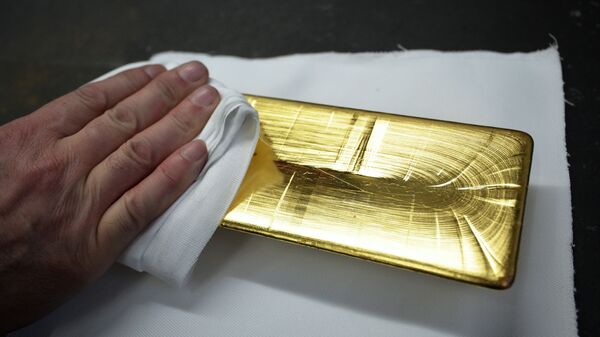As Goldman Sachs has pointed out, there are several strange trends in today’s global economy, with one showing central banks (CBs) increasingly injecting money into electronic coins to better feed markets and simplify money exchange processes.
Meanwhile, billions of dollars in physical currency and precious metals are literally disappearing, as Zero Hedge points out in a recent overview.
Goldman Sachs wrote earlier this week “gold’s strategic case is still strong” in light of “geopolitical uncertainty”, with governments eagerly zeroing in on cash and gold caches. As the investment titan noted, “CBs globally have been buying gold at a very strong pace” and “2019 looks to be a record year for CB gold purchases with our target of 750 tonnes combined purchases likely to be met".
However, there is one peculiar side to the gold-related trend: the bank says there has been an eye-watering 1,200 tons or "unexplained" gold flows worth around $57 billion over the past three years.
"Rising political risk - together with negative European rates - may be an important reason behind the large share of unaccounted gold investment over the past several years”, says Goldman's Mikhail Sprogis, analysing that the “cumulative unexplained gold demand based on World Gold Council (post 2010) and GFMS (pre 2010) balances data”.
He further remarks that since the end of 2016, the “implied build in non-transparent gold investment has been much larger than the build in visible gold ETFs.”
The observation is, as the analyst notes, fully consistent with reports that vault demand shows an upward trend:
“Political risks, in our view, help explain this because if an individual is trying to minimise the risks of sanctions or wealth taxes, then buying physical gold bars and storing them in a vault, where it is more difficult for governments to reach them, makes sense”, Sprogis writes.
Goldman thereby portrays the way there has been tens of billions in gold flows which have vanished into thin air, away from the official records, but are purported to be behind the scenes as the world is bracing itself for a new economic shock.
"Central banks don’t know where they have gone, or why, and are playing detective, trying to crack the same mystery", The Wall Street Journal writes about the same trend, but vis-à-vis hard material money.
“People hide their money everywhere”, said Sven Bertelmann, head of the Bundesbank’s National Analysis Centre in Mainz, Germany, adding:
“Sometimes bank notes are buried in the garden, where they start decomposing, or hidden in attics, where they are used by mice for building nests.
“It happens again and again that people keep money in an envelope and then they shred it by mistake”, Mr Bertelmann said. “We pick up the bank notes with tweezers and then start to put them together, like a jigsaw puzzle,” he explained.
The German central bank is one of those deeply worried about the trend: according to the Bundesbank, more than 150 billion euros are currently hoarded in Germany, with Australia’s central bank reporting that an average of $7.6 billion Australian dollars ($5.2 billion) is missing “at the beach or in couch cushions... or simply lost in a "boating accident" to avoid the taxman until the rainy days arrive”.
Along with printing more cash, a vast number of countries, including Russia, has of late been boosting its gold reserves, mostly by buying gold on the domestic market. Moscow became the biggest buyer of the precious metal in 2018 and is aiming to claim the status in 2019, too.
This trend started roughly at the same time as Russia kicked off its sale of US Treasury bonds, reducing their value in the nation’s portfolio from $92 billion to $10.07 billion in US debt.

